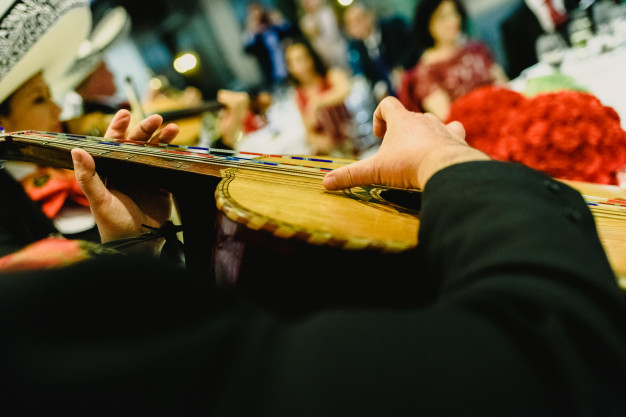Latin music genres
Latin music evolved during the Spanish and Portuguese conquest of America in 1492. The term “Latin music” refers to its geographical origin in Latin American countries, including the Caribbean and Central/South America, where cultural diversity has resulted in an audible richness. Indigenous instruments like the bamboo penpipe and trumpet were used prior to the arrival of Europeans. As Westerners introduced new instruments, such as the violin, harp, and guitar, native Latin American artists adapted and created new pieces. A blend of cultural traditions has shaped the sound of Latin music.
Location of Latin music genre
Geographically, it refers to the Spanish and Portuguese regions of Latin America, but sometimes the French-speaking countries and the Caribbean and South American regions also include central African-influenced areas
Important instruments of the Latin music
Birimbao (a Brazilian bowman), Marimba (a kind of African percussion), Tuna and Toncal (Mayan drums), flutes (such as pincollos and Quena), PanFlute (such as Sikouris, Antara, Zampona), Trumpet, Various percussions, wind instruments, string instruments, guitar instrument, guitar strings similar to lute, mandolin, harp, violin, classical and viola;

Music photo created by freepik – www.freepik.com
Famous artists in Latin music
Carlos Chavez, Alberto Ginastera, Osvaldo Golijov, Mozart Camargo Guarnieri, Rodolfo Halffter and Astor Piazzolla are well-known names in Latin music.
Key features of American Latin music
The Latin music genre, encompassing a variety of rhythms and styles from Spanish-speaking countries like Latin America and Spain and Portuguese-speaking countries like Brazil and Portugal, is widely popular. Influenced by American music, jazz, and blues, the language used in this genre is primarily Spanish, Portuguese, and partly French. African rhythm has also had a significant impact on popular Latin genres like Dominican Merengue, Bomba, Cuban Rumba, and Puerto Rican Salsa.
Latin music styles
Because of the variety of countries and cultures that make up Latin music, this style is subdivided into different sub-genres and sub-genres, each with its own unique style, but with many other sub-genres of the genre. One of the most popular musical genres of Latin Tango is the Argentinean Tango, which is also popular in many countries. Brazilian Samba and Salsa are among the other sub-genres that have a huge following among the diverse subsets of the Latin music genre.
The genre features Spanish Desmica (Latin American Traditional Poetry Composition Index) and syncope (emphasis on weak rhythmic bits rather than strong bits).
Read more: Japanese music culture
Introducing Latin Music Styles
The most important sub-genres of Latin are Samba (Brazilian), Salsa (Cuban), Reggaeton, Flamenco (Spanish), Tango, and, depending on the geographical region of the genre, there is a wide variety of them:
Common in different areas: salsa, balada, bolero, pasodoble, tropical, rock, and rap, aguinaldo;
Mexico and Central America: Corrido, Tejano, Son, Tonada;
The Caribbean and surrounding areas: Danzon, Guajira, Rumba, Son, Charanga, Riga and Rigaton, Boogaloo, Mambo, Marang, Bachata, Kombi cumbia) ؛
Andean and Ecuador and Puerto Rico: Pasillo, Dazante, Chicha
Brazil: sertaneja, samba, forro, baiao, ax;
Paraguay and Argentina: guarania, polka paraguaya, galopera, chamame;
Spain: Flamenco.
Related genres Latin music genre;
Bachata, bossa nova, merengue, rumba, salsa, samba, son and tango, Tejano, Latin pop, Urban Latin music, Brazilian music, Latin rock, and alternative music.
Latin music in South America is not only influenced by indigenous European culture and modern European instruments, and the forced migration of African slaves to the continent has had an undeniable impact on this style of music. All in all, Latin music reflects the historical complexity and cultural diversity of the countries that have formed the Latin America region together, and the interesting thing about this geographic region is that it results from all the historical ups and downs in this part of the world of formation. There has been a style of music that many people around the world enjoy listening to.
Brazilian music
The most popular Brazilian music styles are Samba and Boza Nova, which is widespread throughout the country. Brazil is the fifth country in the world to have a variety of cultures, so there is also a variety of music in Brazilian folk music.
After the Portuguese became Brazilian in 1500, they realized that the local people of Brazil could not be forced to work in slavery, so they brought African slaves to work. As a result, Brazilian music combined African and European music.
Brazilian African and European traditions vary in rhythm and dance form, with Portuguese being the dominant language, not Spanish.
Read more: African native music
Samba
In the late 19th century, the style of samba music emerged as a popular style in Brazil. Samba music, a mix of Brazilian dances with music, quickly became popular in the country, so early in the century samba music was broadcast on the radio and Brazilians enjoyed dancing to music.
Choro and Sertaneja
Choro and Sertaneja are some of the most popular Latin America music styles formed in Brazil. The choro style was born in Rio de Janeiro in the 19th century. Choro is usually played with a guitar, a flute and a kavakio, which creates a beautiful mix.
Sertaneja music is a traditional style that resembles country style. It is actually quite popular in Brazil but not abroad. This genre comes from sertao and caipira, two traditional Brazilian music genres. In addition to the aforementioned styles, Brazil also has many traditional styles, such as Maracato, Afox, Freu and Foro.
Ranchera and Sones Styles (Mexico)
Ranchera is one of the most popular styles of Latin American traditional music. At first the style was played as a guitar solo but later developed and performed in full bands. During the Mexican Revolution, Ranchera’s music helped greatly promote Mexican culture.
The sons style originated older than Ranchera and two centuries before, a blend of Mexican, African and Spanish folk music. The combination of this style has made it versatile and flexible so that it has a variety of cultural effects.
Cumbia (Colombia)
The most well-known traditional style of Colombian music is the Cumbia style, which exhibits well the features of Latin music. This style is performed with heavy percussion and flute accompaniment that will have a good effect on the audience and provide the appropriate Colombian rhythms for the dance. The Cumbia style in Mexico has many fans.
In addition to the styles mentioned, there are other types of music and dance in Latin music, each representing its own cultural features. This is an attempt to summarize important parts of Latin music in a nutshell.
If you’re a musician looking for the opportunity to showcase your talents on a global stage, look no further than the InterContinental Music Awards. As one of the most prestigious music awards in the world, the InterContinental Music Awards recognize and celebrate the best in music across all genres and regions.
You’ll have the opportunity to be heard by music industry executives and be internationally recognized.
So don’t wait – submit your music to the InterContinental Music Awards today and take the first step towards global recognition and success by clicking here!


